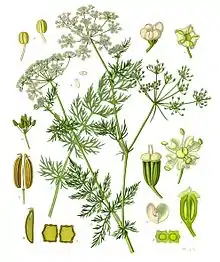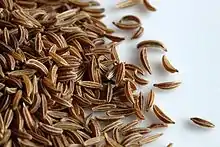Caraway
Caraway, also known as meridian fennel[1] and Persian cumin[1] (Carum carvi), is a biennial plant in the family Apiaceae,[2] native to western Asia, Europe, and North Africa.[3][4][5][6]
| Caraway | |
|---|---|
 | |
| Scientific classification | |
| Kingdom: | Plantae |
| Clade: | Tracheophytes |
| Clade: | Angiosperms |
| Clade: | Eudicots |
| Clade: | Asterids |
| Order: | Apiales |
| Family: | Apiaceae |
| Genus: | Carum |
| Species: | C. carvi |
| Binomial name | |
| Carum carvi | |
The plant is similar in appearance to other members of the carrot family, with finely divided, feathery leaves with thread-like divisions, growing on 20–30 cm (7.9–11.8 in) stems. The main flower stem is 40–60 cm (16–24 in) tall, with small white or pink flowers in umbels. Caraway fruits, commonly (erroneously) called seeds, are crescent-shaped achenes, around 2 mm (0.08 in) long, with five pale ridges.
| Nutritional value per 100 g (3.5 oz) | |
|---|---|
| Energy | 333 kcal (1,390 kJ) |
49.90 g | |
| Sugars | 0.64 g |
| Dietary fiber | 38.0 g |
14.59 g | |
| Saturated | 0.620 g |
| Monounsaturated | 7.125 g |
| Polyunsaturated | 3.272 g |
19.77 g | |
| Vitamins | Quantity %DV† |
| Vitamin A equiv. | 2% 18 μg |
| Thiamine (B1) | 33% 0.383 mg |
| Riboflavin (B2) | 32% 0.379 mg |
| Niacin (B3) | 24% 3.606 mg |
| Vitamin B6 | 28% 0.360 mg |
| Folate (B9) | 3% 10 μg |
| Vitamin C | 25% 21.0 mg |
| Vitamin E | 17% 2.5 mg |
| Vitamin K | 0% 0 μg |
| Minerals | Quantity %DV† |
| Calcium | 69% 689 mg |
| Iron | 125% 16.23 mg |
| Magnesium | 73% 258 mg |
| Phosphorus | 81% 568 mg |
| Potassium | 29% 1351 mg |
| Sodium | 1% 17 mg |
| Zinc | 58% 5.5 mg |
| Other constituents | Quantity |
| Water | 9.87 g |
| |
| †Percentages are roughly approximated using US recommendations for adults. Source: USDA FoodData Central | |
Names
The etymology of caraway is complex and poorly understood. Caraway has been called by many names in different regions, with names deriving from the Latin cuminum (cumin), the Greek karon (again, cumin), which was adapted into Latin as carum (now meaning caraway), and the Sanskrit karavi, sometimes translated as "caraway", but other times understood to mean "fennel".[7]
English use of the term caraway dates back to at least 1440,[8] and is considered by Walter William Skeat to be of Arabic origin, though Gernot Katzer believes the Arabic al-karawya كراوية (cf. Spanish alcaravea) to be derived from the Latin carum.[7]
History
Caraway was mentioned by the Greek Dioscorides as a herb and tonic. It was later mentioned in the Roman Apicius as an ingredient in recipes.[9] Later, caraway was known in the Arab world as karauya, and cultivated in Morocco.[9]
Uses

The fruits, usually used whole, have a pungent, anise-like flavor and aroma that comes from essential oils, mostly carvone, limonene,[10] and anethole.[11] Caraway is used as a spice in breads, especially rye bread.[12]
Caraway is also used in desserts, liquors, casseroles, and other foods. Its leaves can be added to salads, stews, and soups, and are sometimes consumed as herbs, either raw, dried, or cooked, similar to parsley.[3] The root is consumed as a winter root vegetable in some places, similar to parsnips.[3][12]
Caraway fruits are found in diverse European cuisines and dishes, for example sauerkraut, and caraway seed cake. In Austrian cuisine it is used to season beef and, in German cuisine, pork. In Hungarian cuisine it is added to goulash, and in Norwegian cuisine and Swedish cuisine it is used for making caraway black bread.[12]
In Hungary and Serbia, caraway is commonly sprinkled over home-made salty scones (köményes pogácsa / pogačice s kimom). It is also used to add flavor to cheeses such as bondost, pultost, havarti, and Tilsit.
Caraway oil is used to for the production of Kümmel liquor in Germany and Russia, Scandinavian akvavit, Icelandic brennivín.[12]
In Middle Eastern cuisine, caraway pudding, called meghli, is a popular dessert during Ramadan. It is typically made and served in the Levant area in winter and on the occasion of having a new baby. Caraway is also added to flavor harissa, a North African chili pepper paste. In Aleppian Syrian cuisine it is used to make the sweet scones named keleacha.
Caraway fruit oil is also used as a fragrance component in soaps, lotions, and perfumes. Caraway is also used as a breath freshener, and it has a long tradition of use in folk medicine.
In the United States, the most common use of caraway is whole as an addition to rye bread – often called seeded rye or Jewish rye bread. Caraway fruits are frequently used in Irish soda bread, along with raisins and currants.
Cultivation
Caraway is distributed throughout practically all of Europe except the Mediterranean region; it is widely established as a cultivated plant. All other European species of Carum generally have smaller fruits; some grow on rocks in the mountains, chiefly in the Balkans, Italian Alps and Apennines. However the only one that is cultivated is Carum carvi, its fruits being used in many ways in cooking and its essential oils in the preparation of certain medicines and liqueurs.[13]
The plant prefers warm, sunny locations and well-drained soil rich in organic matter. In warmer regions, it is planted in the winter as an annual. In temperate climates, it is planted as a summer annual or biennial. However, a polyploid variant (with four haploid sets=4n) of this plant was found to be perennial.
Finland supplies about 28% (2011) of the world's caraway production from some 1500 farms, the high output occurring possibly from its favorable climate and latitudes, which ensure long summer hours of sunlight.[14]
References
- Caraway
- USDA Plants Classification Report: Apiaceae Archived 2015-09-27 at the Wayback Machine
- "Caraway". About.com. Retrieved February 16, 2016.
- "Anise Seed Substitute". Buzzle.com. Archived from the original on September 15, 2015. Retrieved February 16, 2016.
- "English Malayalam Spice Names". Recipes.malayali.me. November 7, 2008. Retrieved January 25, 2013.
- "Caraway". Word Crops Database. Retrieved February 16, 2016.
- Katzer's Spice Pages: Caraway Caraway (Carum carvi L.)
- Walter William Skeat, Principles of English etymology, Volume 2, page 319. 1891 Words of Arabic Origin
- Pickersgill, Barbara (2005). Prance, Ghillean; Nesbitt, Mark (eds.). The Cultural History of Plants. Routledge. p. 157. ISBN 0415927463.
- "Chemical Composition and Antiulcerogenic Activity of the Volatile Oil from Carum Carvi". Archived from the original on March 4, 2014.
- María D. López; María J. Jordán; María J. Pascual-Villalobo (2008). "Toxic compounds in essential oils of coriander, caraway and basil active against stored rice pests". Journal of Stored Products Research. 44 (3): 273–278. doi:10.1016/j.jspr.2008.02.005.
- Rodale's Illustrated Encyclopedia of Herbs
- Tomanová, Eliška (1998). Wild Flowers. Prague, Czech Republic: Aventinum Nakladatelství. p. 113. ISBN 978-1-84067-046-2.
- "Finland a Global Leader in Caraway Exports". FinnFacts. April 22, 2013. Archived from the original on April 19, 2014. Retrieved April 19, 2014.
External links
 This article incorporates text from a publication now in the public domain: Chisholm, Hugh, ed. (1911). "caraway". Encyclopædia Britannica (11th ed.). Cambridge University Press.
This article incorporates text from a publication now in the public domain: Chisholm, Hugh, ed. (1911). "caraway". Encyclopædia Britannica (11th ed.). Cambridge University Press.